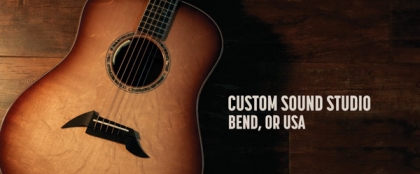Here are some pointers about ordering a Custom from our friends at Breedlove guitars that we think will help regardless of the brand you ae considering.
Designing a custom acoustic instrument with the Custom Sound Studio team in Bend, OR is an amazing experience for guitar enthusiasts. Imagine walking into the private design space and having an entire day to learn about all of the custom options, body shapes and details which go into a custom instrument - then working with the design team to pick out all of the specific tonewoods and distinct elements to make your dream instrument. While this process is considered the ultimate treat by some, it can also be somewhat overwhelming for the 1st time designer. But worry not, our experienced team loves working with new designers and will patiently walk you through the entire process. To offer some additional insight into the design process, we recently interviewed our top Sound Studio designer, Erika Mohr, for an inside look at what a custom guitar buyer needs to consider.
Body Shape
The body shape is a very important aspect of the build. We offer a variety of body shapes, such as dreadnought, concert, parlor, auditorium and jumbo. Each body shape is responsible for producing unique tonal complexities. To learn more, check out these body shape videos from our Custom Sound Studio Website.
Top Wood
It is argued that upward os 80% of the tonal property of an acoustic guitar comes from the top. The top serves as the soundboard for the movement of the strings and produces sounds dependent on the wood type used. Wood choices range from softer woods such as Redwood and Western Red Cedar that lend themselves well to a softer touches and fingerstyle playing to stiffer woods such as Adirondack Spruce and Bear Claw Sitka Spruce that stand up to an aggressive playing style and project into the audience. View examples of the various tonewoods.
Back and Side Wood
Back & Side woods are instrumental in providing tonal characteristics of the guitar such as bass and treble character of the instrument. A wood such as Maple lends a treble character to the guitar and produces a note to note clarity that makes it desired for recording. On the other end of the spectrum, woods in the Rosewood family such as East Indian Rosewood, Brazilian Rosewood and Cocobolo are heralded for their strong bass response. The spectrum of back and sides woods are varied in their looks and sound properties and offer something for everyone. View examples of the various tonewoods.
Finish
Many custom guitars are finished with a clear coat of finish that highlights the figure, color and grain of the fine tonewoods used. Also available to enhance appearance of the guitar are a selection of opaque to transparent bursts and stains. Some color finishes are subtle and serve to highlight the natural character of the wood such as an aged toner top. This transparent stain serves to warm up the golden hues of spruce top to mimic the aging process of a guitar top. It also pulls out the striking cross-striations of Bear Claw Sitka Spruce. Other color work in the form of bursts can range from subtle banded bursts to more dramatic teardrop burst. The color options are endless.
Binding Package
The binding serves to create clean zones of distinction between the top, back and sides woods and offer a decorative and structural element to the guitar design. The looks range from simple black plastic to exotic wood binding such as Bloodwood or Koa binding. Purfling on the top back and sides help sharpen the zones of transition between the wood. Purfling can be as simple as black/white/black lines to much more complex and noticeable Abalone purfling or Herringbone marquetry.
Inlay
Inlay is a way to deeply personalize an instrument. Choose a standard inlay that expresses your style ranging from the simple and clean Offset dots position markers to the more intricate stylings of a River of Life inlay. Collaborate with our inlay design team to design your own unique inlay. The final custom design may spring from an abstract conversation that is interpreted to the fingerboard canvas to a inlay based off of a concrete drawing or photo. The use of various inlay materials help bring the inlay alive with color and movement. The materials range from iridescent shell: Abalone, Mother of Pearl, Sea Snail to the bright colors of reconstituted stone: Lapis Lazuli, Turquoise, Coral, and Agate to name but a few of the options available.
Give us a call when you are ready to build that special guitar. We are the top custom shop dealers for every brand we carry, so you are in good hands.


